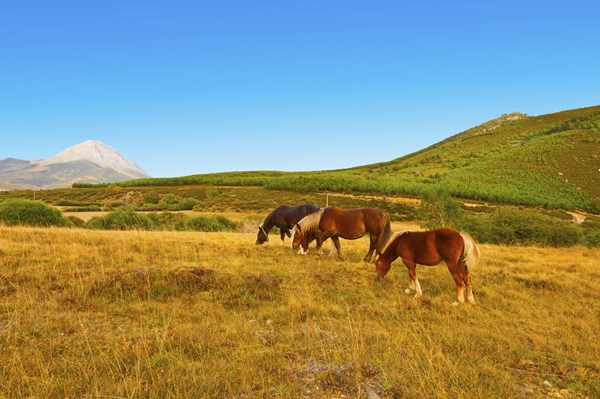 Credit: Thinkstock Deteriorating pasture quality might mean your horse needs a diet overhaul.
Credit: Thinkstock Deteriorating pasture quality might mean your horse needs a diet overhaul.As summer transitions into autumn, new horse-keeping challenges arise. Be on the lookout for these four potential problems.
1. Deteriorating pasture quality warrants a diet overhaul.
“In the spring, we are often concerned about the pasture being too good in quality or high in fructans, which sometimes mandates the use of drylots and grazing muzzles to minimize intake. In the fall, the quality of the pasture could decline significantly, so much so that extra energy from supplemental feeds might be necessary for balanced nutrition,” advised Peter Huntington, BVSc, MACVSc, director of nutrition for Kentucky Equine Research (Australia).
This means that horses doing well with just a well-fortified supplement in spring and summer may need extra concentrates in the fall.
Don’t forget these basic feeding facts when overhauling your horse’s diet:
- The best forage possible should always be provided (apart from horses needing lower energy forages to assist weight loss);
- Changes in diet must be made slowly;
- Consider all of the feeds and nutritional supplements your horse receives to avoid nutrient imbalances; and
- Seek professional advice in creating a balanced diet for your horse.
2. Fall pasture or forage can present risks.
“High levels of fructans and water-soluble carbohydrates often cause owners strife in spring, but even fall pastures and late-cut forages can produce health issues in at-risk horses,” advised Huntington. Over-consumption of fructans and water-soluble carbohydrates can cause laminitis in certain horses.
Unsure about forage quality? Forage analysis can be done year-round, and is especially important for those horses with insulin resistance or equine metabolic syndrome.
3. Wilting maple leaves can leave you horseless.
Several weeds and plants are potentially dangerous to horses in autumn. One such example is moldy, wilting maple leaves. Research has shown that seeds and leaves from maples and related species contain a chemical toxin, hypoglycin A, which causes atypical myopathy, also known as pasture-associated myopathy.
“Atypical myopathy is most commonly seen in North America and Europe. In the Southern Hemisphere, the most concerning weeds and plants on pastures in the autumn include ryegrass in New Zealand, which causes staggers, and flatweed in Australia, which can trigger stringhalt,” added Huntington.
4. Manure misery leads to parasite woes.
Manure management is always a pressing matter and needs to be maintained to maximize the health of horses and foals. By thoroughly removing manure from a stable and nearby paddocks and lots, the likelihood of re-infestation from one season to the next diminishes greatly. This is particularly true of bots and roundworms.
In addition to manure management, appropriate deworming based on fecal egg counts should be employed as needed.
Visit equinews.com/newsletters to subscribe to The Weekly Feed, KER’s award-winning equine nutrition newsletter.


